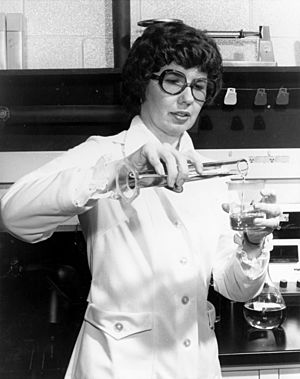Barbara Askins facts for kids
Quick facts for kids
Barbara Askins
|
|
|---|---|

Askins in 1977
|
|
| Born | 1939 (age 85–86) Belfast, Tennessee, U.S.
|
| Alma mater | University of Alabama in Huntsville |
| Awards | National Inventor of the Year |
| Scientific career | |
| Fields | Chemistry |
| Institutions | Marshall Space Flight Center |
Barbara S. Askins (born in 1939) is an amazing American chemist. She is famous for inventing a special way to make pictures clearer, especially those that were too dark or underexposed. This invention was super helpful for NASA and doctors, and it even earned her the title of National Inventor of the Year in 1978.
Contents
Barbara Askins' Early Life and Education
Barbara Askins was born in Belfast, Tennessee, in 1939. She started her career as a teacher. After her two children began school, Barbara decided to go back to college. She studied hard and earned both her bachelor's and master's degrees in chemistry. In 1975, she joined NASA's Marshall Space Flight Center.
How Barbara Askins Revolutionized Photography
Barbara Askins is a physical chemist. She worked for NASA's Marshall Space Flight Center. She is best known for her amazing invention that made "invisible" images visible. She found a way to make pictures on developed film much clearer. She did this by making the silver in the image radioactive. Then, she used this radiation to create a second, much clearer picture.
Making the Invisible Visible
The new picture created by her method is called an autoradiograph. It showed images with much more detail and contrast. Her groundbreaking method helped improve pictures that were too dark. It also made it possible to see things that were almost impossible to detect before. This was incredibly useful for many things. For example, it helped scientists get important information from space images. These images might have been too dark to see clearly. This included pictures looking deep into space or showing the geology of other planets.
Helping Doctors and Restoring Old Photos
Askins' invention also led to big improvements in medical technology. Her method helped make X-ray images much better. Even X-ray pictures that were 96 percent too dark could suddenly be read! This meant doctors could use much less X-ray radiation on patients. This was great for routine check-ups or emergency tests. Later, Askins' process was also used to fix and restore old photographs. She received a patent for her invention in 1978 (U.S. patent No. 4,101,780). NASA used her invention a lot for their research and development work.
Awards and Professional Groups
In 1978, Barbara Askins was named the National Inventor of the Year. This award came from the Association for Advancement of Inventions and Innovations. She was the first woman to ever receive this special honor by herself.
Barbara Askins is also a member of several important professional groups. These include the American Chemical Society, the Sigma Xi honorary research Society, the American Association for the Advancement of Science, and the World Future Society.
See also
 In Spanish: Barbara Askins para niños
In Spanish: Barbara Askins para niños

